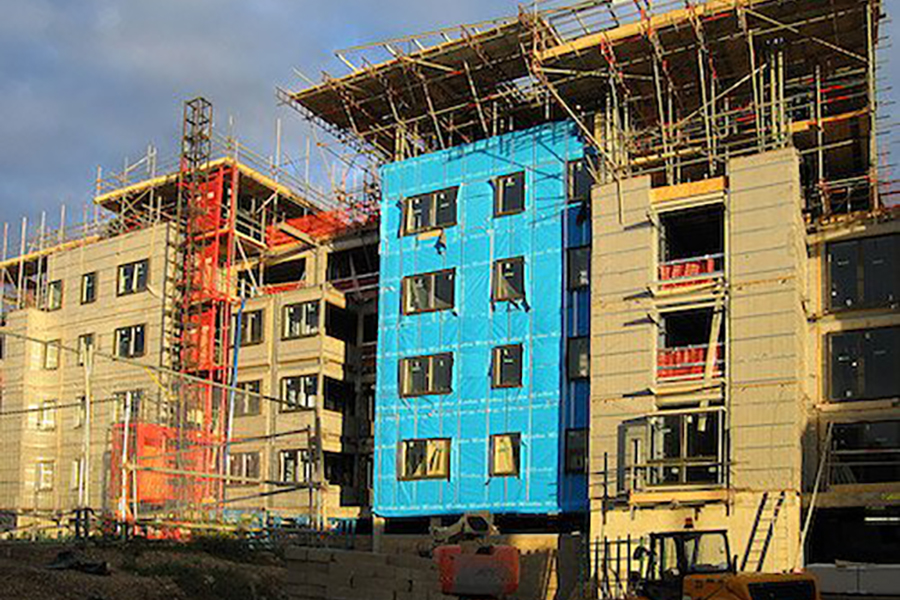A national energy retrofit conference in Montreal in June captured the momentum of a sector that is beginning to scale up, but still scrambling to hit the volume and speed that will deliver on Canada’s commitments for emission reductions and net-zero buildings.
“This is kind of like Disney World for energy efficiency nerds,” Efficiency Canada Executive Director Corey Diamond told the Retrofit Canada opening plenary June 13, with the “intertwining strands” of public sector policy and private sector action helping to push the work forward.
Last year’s conference laid out five priorities for policy action, Diamond said: stronger building codes, launch of an energy retrofit mission, efficiency standards for existing buildings, equitable retrofit measures that leave no one behind, and regulation where needed to hit a tough set of targets. While the retrofit community has “moved the needle” since then, “we have a long way to go, with the physics of climate change reminding us every day” that the clock is running.
“We can feel it. We can smell it,” Diamond told participants. “Incremental change isn’t going to cut it anymore.”
Geneviève Gauthier, national director of consulting services at Montreal-based Econoler, stressed the role of building managers in accelerating energy efficiency strategies and solutions. “In order to succeed,” she declared, “we need to think outside the box, and we can’t think outside the box if we keep on doing the same things.”
Gauthier said private sector practitioners often point to government policies and programs that “are very far from what people see in their real lives, the struggles we have,” and that aren’t designed to deliver what buildings need. But she urged participants to treat those disconnects as a starting point for dialogue: most local governments across Canada “have an open mindset to listen to real-world problems, to try to come up with good programs and policies,” she said, “so please share.”
Betsy Agar, buildings program director at the Calgary-based Pembina Institute, cited building upgrades as the “most important thing we can do” to bring Canada’s climate pollution to net-zero. The success of that effort, she added, will depend on demonstrating that energy-efficient and net-zero homes are also more affordable.
“The thing is that people aren’t living in homes that are affordable to them,” she said, adding that the oldest homes are often the ones in greatest need of upgrades. So if affordability is on track to becoming an argument against energy retrofits, “we need to make it an argument in favour.”
A program that is affordable for individual homeowners and occupants will still call for big-picture investments of C$10 to $15 billion per year, Agar added, with early estimates suggesting an incremental cost of $80,000 per deep energy retrofit. But those numbers will also translate into 200,000 long-term jobs, $48 billion in economic activity, plus $2.50 in tax revenue and $3 to $6 in avoided costs for every dollar governments invest.
Andy Collier, manager of programs and services at Efficiency PEI, described a comprehensive home comfort program that offered deep energy retrofits to low-income clients—comprising everything from energy audits and free upgrades, to windows, to heat recovery ventilators. “If the building needed it, we did it,” he said.
The program has been slowed down by the building industry’s limited capacity to carry out the retrofits, and it initially faced long lead times to get contracts in place. Now, the province works directly with contractors to deliver services on behalf of a client, rather than clients having to do their own research and solicit bids.
Capacity is still a problem, wait times still aren’t ideal, but Collier said delays are down to six months from an average of 12 to 14. And the new approach offers occupants more guidance, taking the guesswork out of the decision on which upgrades will deliver the best results.
He added that PEI has emphasized efficiency over fuel switching because, “at the end of the day, what you heat with doesn’t matter if you’ve got a well-insulated home.” While other panelists and participants made the equal and opposite argument–that good insulation is less important when heat pumps are so efficient—Collier said a home that meets the Passive House standard costs just $100 per year to heat with electric resistance heaters.
“Yes, you can put in a heat pump, and it’s two to three times more energy-efficient,” he said. “But if that’s from a base of $100 per year, it really doesn’t make any difference what you’re heating with.”
The program shifted focus when the province brought it to two Indigenous communities on the island, Collier added. One of the two was most interested in capacity-building for a band-owned construction company; the other was looking for consulting support for a community energy strategy. Those conversations showed the importance of real relationship-building, he said, “instead of saying ‘here’s the program, fill in an application form’.”
Ben Copp, senior director of demand policy and analysis at the federal Office of Energy Efficiency, said Ottawa is currently investing $1.5 million per day to help Canadians retrofit their homes. Even if the recipients of those grants “are arguably middle- and upper-class,” he added, the work raises awareness of the importance of energy efficiency and is helping to bring key partners together in a national strategy.
Copp agreed that funding programs must “meet Canadians where they’re at,” with flexibility to reflect regional differences. “But it’s not just about money,” he said. “We do understand that it’s about capacity and skills, too,” with deliberate efforts to bring on the labour force to meet ambitious retrofit objectives.
Sean Pander, green building manager for the City of Vancouver, said he’d begun to hear about commercial portfolio owners who were planning ahead for 80% greenhouse gas reductions after the city enacted Canada’s first municipal building performance standard. The standard includes emission limits for commercial buildings that take effect in 2026, and will ratchet down over time.
With a fee of $375 per tonne of carbon dioxide or equivalent (CO2e) for buildings that are out of compliance, the standard “tells industry that it’s not just talk. It’s not just pilot projects,” Pander said. And as a result, “it’s where industry is ready to move.”
One “powerful” aspect of Vancouver’s approach is a 2040 deadline for commercial buildings to meet a heating energy limit of almost exactly one gigajoule per square foot, regardless of occupancy or internal loads. Across 36 case studies, he said 30 show a positive return on owners’ investment, and the rest “are only small negative numbers.” But a key feature is the immediacy of a target date that is only 17 years away.
“Each building will only have one cost-effective opportunity between now and 2040,” Pander said, “and yours might be this year or next.
The two-day conference generated a flurry of content on energy retrofit technologies, financing, and regulation, with panelists presenting successful retrofit case studies and talking about how to build buy-in for deeper retrofits for different asset types and building industry segments. Specific approaches like The Netherlands’ Energiesprong model received a lot of attention, including a shout-out from Toronto-area MP Julie Dabrusin, parliamentary secretary to both Natural Resources Minister Jonathan Wilkinson and Environment and Climate Minister Steven Guilbeault.
But “the purpose of taking a market development approach is to look at your market and see what’s out there and what’s missing,” said Sharon Coward, executive director of the EnviroCentre in Ottawa. With multiple different housing archetypes and building performance characteristics in different parts of the country, she added, “the important thing is to design your model to match your context.”
“Often the lesson learned is in the process, not the product,” agreed Lynne Strickland, director of net zero energy initiatives at the Canadian Home Builders’ Association. “The process of how [a project] came to that solution and pulling lessons learned from that is also what we need to look at, rather than just the material solution that came out it.”
But the impatience to get moving on mass, deep retrofits came through from individual participants, one of whom pointed out that all the good work under way would still fall far short of the challenge of retrofitting the entire building stock by 2040 or 2050. The sector’s success will be more obvious, he said, when the impressive photos of successful, flagship projects are posted alongside charts summarizing the 10,000 retrofits in a single portfolio.
This story originally appeared at The Energy Mix and is republished here as part of Covering Climate Now, a global journalism collaboration strengthening coverage of the climate story.






